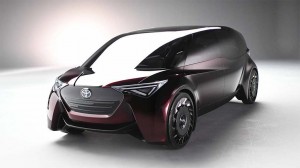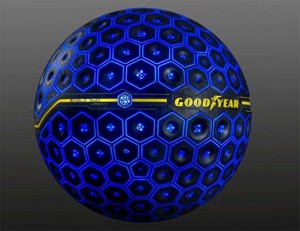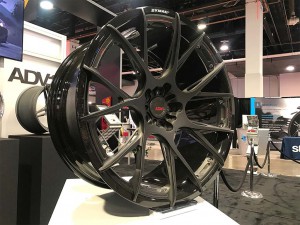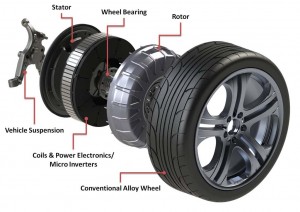If Toyota has its way you soon might be running around on airless tires. That doesn’t mean you’ll be riding a flat, though.
The Japanese automaker’s Fine-Comfort Ride concept car, which is making its debut at the Tokyo Motor Show, features tires that don’t need to be inflated to be used. The airless design “contributes to greater safety and peace of mind,” according tire manufacturer Sumitomo, “by freeing the driver from worries about punctures and the trouble of having to manage tire pressure.”
Sumitomo isn’t the only manufacturer hoping to develop an airless tire. Michelin is working on a similar concept it has dubbed the “Tweel.” And though neither company is saying when such a design might make it into production, what seems clear is that motorists are going to see a lot of changes in wheels and tires in the coming years, reflecting broader technological changes reshaping the automobile.
Toyota officials explain that there are several potential advantages to airless tires. They can’t go flat, for one thing, the design using a band of rubber surrounding a hub made up of plastic and aluminum that can absorb the punishment tires routinely suffer through without being inflated.
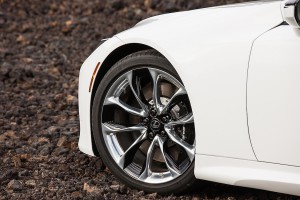
Some manufacturers have eliminated the spare tire in favor of run-flat tires, such as in the Lexus LC 500.
The design is also lighter, and Toyota is targeting ways to reduce the weight of its tires by 11 pounds, or about 30 percent, by 2025. Lower mass means improved fuel economy – or with battery-electric and hydrogen-electric vehicles, improved range.
The Fine-Comfort Ride is a fuel-cell vehicle and Toyota has taken steps to improve the efficiency of the entire vehicle to yield a range of 621 miles on a tank of hydrogen, about twice as far as its current production FCV, the Mirai, can manage.
Along with the unusual tire design, Toyota also opted for using hub motors, four individual motors mounted within the wheels. That’s an approach a number of companies have been working on as a way to take all-wheel-drive to the next level, among other things. The downside is that hub motors add to what is known as unsprung mass. The lighter, airless Sumitomo tires help offset that problem.
It’s far from certain if, never mind when, airless tires will show up in your local showroom. But automakers and their tire suppliers are looking at a variety of other tire technologies, some already in production. According to a recent survey by AAA, 28% of the vehicles sold during the 2017 model-year came without spares. A significant number of those were equipped with run-flat technology.
(Spare me. Click Here to find out why the spare tire is an endangered species.)
Unlike the airless tires being developed by Sumitomo, Michelin and Bridgestone, run-flats aren’t designed to be used for an extensive period once deflated. They rely on stiff sidewalls to carry the load for not much more than about 50 miles or so after a puncture. Not everyone is fond of run-flats. They tend to saddle the vehicle with a rougher ride, but newer designs are helping improve ride comfort.
Every vehicle now being sold in the U.S. is equipped with a federally mandated tire pressure monitoring system, or TPMS, meant to indicate when a tire starts to lose pressure. Some systems simply flash an idiot light requiring the driver to check to see which tires is going soft, while more advanced TPMS systems give readouts for each individual wheel.
Going forward, several manufacturers are working on tires that incorporate even more sophisticated sensors that can tell the vehicle about such things as road and weather conditions. That could prove especially important for the upcoming era of autonomous and fully driverless vehicles.
“By steadily reducing the driver interaction and intervention in self-driving vehicles, tires will play an even more important role as the primary link to the road,” says Joseph Zekoski, Goodyear’s senior vice president and chief technical officer.
Right now, it can be difficult for brake-based systems, such as electronic stability control, to determine whether a skid is the result of snow, ice or even gravel or sand, but each must be dealt with separately. Goodyear’s experimental Intelligrip tire has built in sensors that could improve the safety and reliability of hands-free vehicles significantly, experts contend.
Goodyear has even shown off a tire, called the Eagle 360 Urban, that is as round as a beach ball and uses artificial intelligence, the manufacturer claims, “to sense, decide, transform and interact.”
“Made of super-elastic polymer, the tire’s bionic skin has a flexibility similar to that of human skin,” Goodyear explains, “allowing it to expand and contract. This outer layer covers a foam-like material that is strong enough to remain flexible despite the weight of a vehicle. Thanks to this flexibility, actuator elements beneath the tire’s surface, which are components that change shape with an electrical input, working like human muscles, can re-shape the individual sections of the tire’s tread design, adding ‘dimples’ for wet conditions or smoothing the tread for dry conditions.”
While the Goodyear 360 is likely even more far out into the future than the Sumitomo airless tires, some of these technologies could show up in the near future.
Several manufacturers are now working to replace the rubber that is the dominant material in today’s tires. German supplier Continental Tire, for one, hopes to put the synthetic material, known as taraxa gum, into production “in five to 10 years” as an alternative to conventional rubber tire treads.
You can also expect to see new, lighter materials start to replace those aluminum alloy wheels that have today largely replaced even heavier steel wheels. Several specialty firms are now marketing carbon fiber rims, albeit at an extreme premium and in limited numbers.
With all the changes coming to the automobile in the years ahead, it’s easy to forget about your tires and wheels. But as concept vehicles like the Toyota Fine-Ride Comfort, and wheel concepts like the Goodyear Eagle 360 reveal, tires and wheels are getting swept up in the technology revolution, as well.
(Chevy teams up with Hot Wheels for the annual SEMA Show. Click Here for more.)

